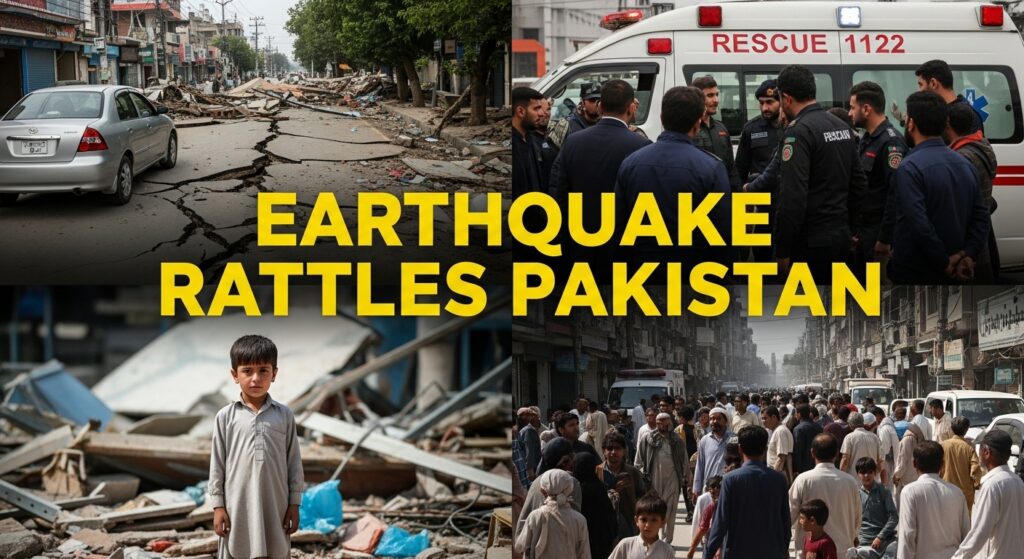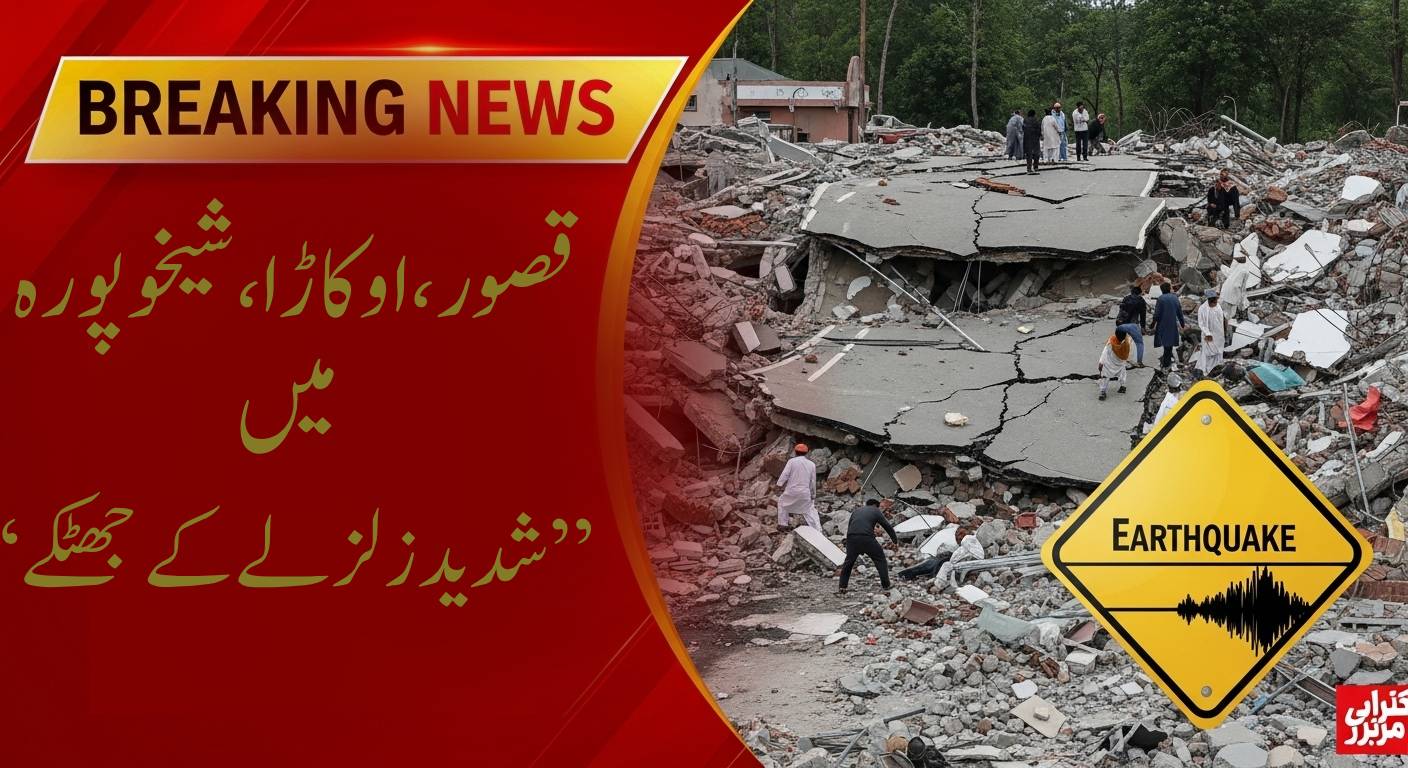Pakistan’s seismic zones experienced multiple earthquakes today. Learn about the M5.5 & M4.1 tremors felt, the country’s vulnerability, and essential preparedness steps. Stay informed on Pakistan’s ongoing seismic activity.
Table of Contents
Breaking News:
Pakistan, a country positioned squarely on one of the world’s most active seismic belts, experienced a notable series of earthquakes today, July 1, 2025, and over the preceding days. While there are no confirmed reports of casualties or major damage, these tremors serve as a powerful reminder of the relentless geological forces at play beneath the Earth’s surface. From shallow quakes near populated areas to deeper events in mountainous regions, the recent seismic activity underscores Pakistan’s inherent vulnerability to earthquakes and the critical importance of continuous monitoring and robust preparedness.
The recent tremors, ranging from moderate to significant magnitudes, have been felt across multiple provinces, causing momentary alarm among residents. Such events are a regular feature of Pakistan’s geological landscape, demanding heightened awareness and a proactive approach to disaster management. This article provides a comprehensive overview of the latest earthquakes to hit Pakistan, delves into the country’s seismic profile, reviews historical impacts, and highlights ongoing efforts in monitoring and disaster resilience. Understanding earthquakes is paramount for a nation living at the confluence of powerful tectonic plates.
Recent Seismic Activity: A Detailed Look at the Latest Earthquakes in Pakistan
The past few days have seen a noticeable uptick in seismic activity across various parts of Pakistan. These earthquakes, while not catastrophic, have been significant enough to register strongly on seismographs and be felt by local populations. Their shallow depths, in some cases, amplify their perceived intensity on the surface.
Today’s Notable Tremors (June 30, 2025):
At 11:10 UTC on June 30, a magnitude 4.1 earthquake struck with its epicenter located near Taunsa, Punjab. What made this particular tremor significant was its extremely shallow depth of just 10 kilometers. Such shallow earthquakes tend to cause more intense shaking at the surface, and true to form, this temblor was strongly felt by residents across nearby towns in Punjab, prompting immediate concern and momentary alarm.
Earlier on June 30, at 07:32 UTC, another earthquake with a magnitude of 4.7 originated near Battagram, Khyber Pakhtunkhwa (KPK). While stronger in magnitude, this quake occurred at a considerably greater depth of approximately 203 kilometers. Deeper earthquakes, even if of higher magnitude, often have their energy dissipated more before reaching the surface, resulting in less intense shaking compared to shallow ones.
Preceding Significant Earthquakes (June 28-29, 2025):
The recent cluster of earthquakes also includes several more potent events from the preceding days, particularly in Balochistan and near Multan. These larger tremors highlight the ongoing seismic stress in the region.
On June 28, at 22:24 UTC, a magnitude 5.3 earthquake hit near Bārkhān, Balochistan, at a shallow depth of 10 kilometers. This was a substantial quake that would have been widely felt across the region, potentially causing minor damage to less resilient structures.
Following this, on June 29, a magnitude 5.5 tremor occurred approximately 149 kilometers west of Multan, Punjab. This was another significant shallow earthquake, also at a depth of 10 kilometers, and was recorded by prominent global seismological centers like GFZ and EMSC.
Adding to the series, a magnitude 5.3 earthquake struck central Pakistan at 3:54 AM local time on June 29, with its epicenter approximately 60 kilometers north-northeast of Barkhan. An earlier magnitude 5.2 tremor was also felt during early Sunday (June 29), albeit at a deeper depth of around 150 kilometers.
Furthermore, various earthquakes ranging from magnitudes 4.4 to 4.6 have been recorded across Balochistan and its coastlines since mid-June, indicating consistent activity.
Despite this concentrated wave of seismic activity, a crucial detail emphasized by authorities is that there have been no confirmed casualties or major structural damage reported from today’s or the very recent seismic activity. This is a testament to both the inherent resilience of some structures and perhaps the specific nature of these quakes.
Why Pakistan is a Hotbed for Earthquakes: The Tectonic Reality
Pakistan’s frequent experience with earthquakes is not a random occurrence but a direct consequence of its unique geological position. The country sits precariously along the convergent boundary of two of the world’s largest and most active tectonic plates: the Indian Plate and the Eurasian Plate.
The Indian Plate is continuously moving northward, colliding and pushing against the more stable Eurasian Plate. This colossal collision creates immense pressure and stress that accumulate along various geological fault lines traversing Pakistan. These include the prominent Main Boundary Thrust (MBT) and Main Mantle Thrust (MMT) in the northern mountainous regions, the Chaman Fault in Balochistan, and other active fracture zones across Punjab and Khyber Pakhtunkhwa.
The stress built up along these fault lines is eventually released in sudden bursts of energy, manifesting as earthquakes. The depth of these earthquakes plays a critical role in their destructive potential. Shallow earthquakes, those occurring at depths of 10 to 30 kilometers, are particularly concerning. Their proximity to the Earth’s surface means that the seismic energy has less distance to dissipate, resulting in stronger surface shaking and a higher potential for damage. The recent quakes, many of which were shallow, exemplify this risk.
This continuous tectonic activity means that earthquakes are an inherent part of Pakistan’s natural landscape. Understanding the dynamics of these plate movements and the location of active faults is fundamental to predicting seismic hazards and developing effective mitigation strategies against future earthquakes.

A Historical Echo: Pakistan’s Enduring Struggle with Major Earthquakes
The recent tremors, though non-destructive, cast a long shadow from Pakistan’s history of devastating earthquakes. These past events serve as poignant reminders of the catastrophic potential of seismic activity and have profoundly shaped the nation’s approach to disaster preparedness and resilience.
The 2005 Kashmir earthquake, a massive M7.6 temblor, remains one of the most tragic natural disasters in Pakistan’s history. It struck on October 8, 2005, primarily affecting Azad Kashmir and Khyber Pakhtunkhwa. The quake resulted in the loss of up to 88,000 lives and displaced an estimated 2.8 million people, leaving widespread destruction in its wake, particularly in cities like Muzaffarabad and Balakot. This catastrophic event propelled Pakistan into a new era of disaster management reforms.
Beyond 2005, other significant earthquakes include:
- 2008 Ziarat, Balochistan: This region was hit by twin M6.4 earthquakes, claiming 215 lives and injuring over 200, highlighting the vulnerability of Balochistan’s rugged terrain.
- 2013 Balochistan earthquake: A powerful M7.8 earthquake struck southwest Balochistan, leading to over 830 fatalities and affecting more than 100,000 people. Its remote location posed significant logistical challenges for rescue operations.
- 2019 Kashmir earthquake: A tremor estimated between M5.4 and M6.0 caused significant damage in Mirpur and adjacent regions, resulting in 40 deaths and 850 injuries, further underscoring the ongoing seismic risk in the northern territories.
Such events are critical benchmarks that inform current policies, building codes, and emergency response frameworks. Each one has provided invaluable, albeit painful, lessons that continue to drive efforts to build a more resilient Pakistan against the threat of future earthquakes.
Vigilance and Advanced Systems: Monitoring & Response to Earthquakes
In response to its high seismic vulnerability, Pakistan has developed a network of monitoring and response systems, often in collaboration with international partners. These systems are crucial for providing timely information and coordinating efforts in the event of earthquakes.
The National Centre for Seismology (NCS), operating under the Pakistan Meteorological Department (PMD), is the primary domestic authority responsible for monitoring seismic activity. The NCS maintains a network of seismological stations across the country, continuously recording ground movements. This data is then analyzed in real-time to detect, locate, and determine the magnitude and depth of earthquakes. The NCS frequently posts quake details on its official social media platforms, providing prompt public updates.
Pakistan also benefits from robust international collaboration with leading global seismological agencies. Organizations such as the United States Geological Survey (USGS), the German Research Centre for Geosciences (GFZ), and the Euro-Mediterranean Seismological Centre (EMSC) regularly record seismic data and provide rapid updates on earthquakes worldwide, including those in Pakistan. Platforms like EarthquakeList.org and EarthquakeTrack are invaluable for real-time public access to seismic data.
Domestically, the Earthquake Reconstruction & Rehabilitation Authority (ERRA), which played a pivotal role in the aftermath of the 2005 Kashmir earthquake, has since been merged with the National Disaster Management Authority (NDMA). This integration aims to create a more streamlined and comprehensive approach to post-quake relief, rehabilitation, and long-term reconstruction efforts. These agencies form the backbone of Pakistan’s coordinated response to earthquakes.
Local Impact: What Residents Are Experiencing Today
For residents in areas recently affected by the tremors, particularly in parts of Punjab and Balochistan, the experience has been one of momentary alarm. Reports indicate that people felt “strong tremors” that “rattled homes,” leading to immediate concern. While these earthquakes did not lead to widespread devastation, the ground shaking was noticeable enough to disrupt daily routines and trigger a natural instinct for safety.
The fact that no formal damage or casualties have been confirmed is a significant relief, especially given the shallow depths of some of the higher-magnitude quakes. This could be attributed to a combination of factors, including the specific geological characteristics of the epicenter, localized soil conditions, and potentially, improved construction practices in some areas over time.
However, the risk of aftershocks remains a very real possibility, and authorities are actively emphasizing safety measures. Residents are advised to stay vigilant and follow official guidelines. The psychological impact of even minor earthquakes can be significant, leading to anxiety and stress among those who experience them. The repeated nature of these tremors reinforces the need for constant readiness.
Forecasting and Mitigating Risk: The Threat of Aftershocks
The recent cluster of multiple high-magnitude earthquakes in rapid succession, particularly those with shallow depths, elevates the chance of aftershocks. Seismologists advise that in such scenarios, the crust around the initial rupture zone adjusts, leading to subsequent, smaller tremors. These aftershocks can range in magnitude, and there is an elevated possibility of them climbing above magnitude 4, potentially causing further minor damage or continued alarm.
The shallow depths of many of the recent quakes amplify this risk, as any subsequent tremors originating close to the surface would result in more intense ground shaking. The active fault lines in the affected regions remain under stress, making ongoing vigilance critical.
Experts advise residents to remain highly vigilant, secure heavy items in their homes, and stay updated through official channels and seismic alerts issued by the PMD and other reliable sources. Understanding the potential for aftershocks is a crucial part of living safely in an earthquake-prone zone. Continuous monitoring helps in issuing timely warnings for any subsequent earthquakes.
Building Resilience: Emergency Preparedness for Earthquakes in Pakistan
Effective emergency preparedness is the cornerstone of minimizing loss of life and property during earthquakes. Pakistan’s authorities and various organizations are actively working to enhance the nation’s earthquake resilience through a multi-pronged approach.
Key recommendations and ongoing efforts include:
- Having an Earthquake Safety Kit: Citizens are encouraged to prepare emergency kits containing essentials to sustain their families for at least 72 hours, including water, non-perishable food, first-aid supplies, flashlights, and a whistle.
- Following Evacuation Routes: Especially crucial for residents of multi-story buildings, understanding and practicing designated evacuation routes can save lives during an earthquake.
- Implementing Retrofitting: For older constructions that predate modern seismic building codes, authorities are promoting and assisting in retrofitting techniques. This involves strengthening existing structures to improve their resistance to earthquakes.
- Conducting Regular Drills: Regular earthquake drills in schools, offices, and homes are essential for reinforcing “Drop, Cover, and Hold On” procedures and familiarizing individuals with safe spots and evacuation protocols.
These measures, when adopted widely, significantly enhance the chances of survival and reduce injuries during earthquakes. Public awareness campaigns are vital to instill these life-saving habits.
The Path to Recovery: Reconstruction Post-Earthquake Efforts
Pakistan has a strong track record of large-scale reconstruction and rehabilitation efforts following major earthquakes. The experiences, particularly after the 2005 Kashmir earthquake, led to the development of sophisticated frameworks for recovery.
Organizations like ERRA (now part of NDMA) have led extensive projects, including:
- Rebuilding Schools, Hospitals, and Homes: Prioritizing the reconstruction of essential public infrastructure and private dwellings using seismic-resistant designs.
- Strengthening Infrastructure: Implementing stringent seismic standards for new construction of roads, bridges, and other critical infrastructure.
- Coordinating with NGOs and Donors: Actively engaging with national and international NGOs, as well as donor agencies, for funding, technical expertise, and resource mobilization during relief and reconstruction phases.
Continued investment in post-disaster reconstruction and preparedness remains vital, given Pakistan’s recurring earthquake risk. Lessons learned from each recovery effort are integrated into future planning, ensuring a more resilient build-back.
Global Collaboration: Strengthening Pakistan’s Earthquake Resilience
Pakistan’s geographical position necessitates strong global partnerships in seismic research and disaster management. Collaboration with international agencies and experts provides invaluable support in enhancing the nation’s capacity to deal with earthquakes.
Key aspects of this collaboration include:
- Seismic Data Sharing: Exchange of real-time seismic data and research findings with global monitoring networks like USGS, GFZ, and EMSC.
- Technical Support: Assistance from UN agencies (e.g., UNDP, OCHA), the International Red Crescent, and organizations like the World Bank for technical expertise, capacity building, and financial support for reconstruction and training.
- Review of Building Codes: International experts often review and advise on Pakistan’s building codes and retrofit methods, ensuring they align with the latest global best practices in earthquake-resistant construction.
These international collaborations are crucial for Pakistan to leverage global knowledge, technology, and resources in its ongoing efforts to build resilience against earthquakes.
Empowering the Public: What You Can Do Right Now for Earthquake Safety
Given the recent seismic activity and Pakistan’s inherent vulnerability, it’s essential for every individual to know how to respond during and after an earthquake. Here are immediate actionable steps:
- Stay Informed: Follow official alerts from the National Centre for Seismology (NCS) on their social media (like X/Twitter), as well as reliable global sources like USGS and GFZ. Do not rely on rumors.
- Prepare an Emergency Kit: Assemble a kit with essentials to sustain your family for at least 72 hours. This should include water, non-perishable food, a first-aid kit, flashlight with extra batteries, a whistle, and copies of important documents.
- Inspect Your Home: Secure heavy furniture, appliances, and vulnerable items like shelves and water heaters to walls to prevent them from toppling during shaking.
- Practice Drills: Regularly reinforce the “Drop, Cover, and Hold On” procedure. Know the safest spots in your home (under sturdy tables, away from windows and heavy furniture) and practice evacuation routes if you live in a multi-story building.
- Look Out for Aftershocks: Be prepared for subsequent tremors in the hours and days following a significant earthquake. Maintain vigilance and do not re-enter damaged buildings until they have been declared safe by authorities.
These simple yet crucial steps can significantly enhance personal and family safety during earthquakes.
Key Takeaways on Earthquakes in Pakistan Today
The recent wave of earthquakes across Pakistan provides several critical insights:
- Frequent Activity: Pakistan faces frequent earthquakes due to its position on active tectonic plate boundaries.
- Recent Tremors: Today’s and recent quakes (June 28-30) included significant events ranging from M4.1 to M5.5, primarily hitting Punjab and Balochistan.
- Shallow Depths: Many of the recent earthquakes were shallow (10 km depth), increasing their impact on the surface.
- No Reported Casualties/Damage: Crucially, despite the strength and shallow depths, there have been no confirmed casualties or major structural damage reported from these specific events.
- Elevated Aftershock Risk: The clustering and magnitude of recent quakes mean the chance of aftershocks, potentially above magnitude 4, remains elevated.
- Strengthening Response: Pakistan continues to fortify its monitoring systems, readiness protocols, and post-disaster reconstruction capabilities.
Final Summary: Pakistan’s Ongoing Resilience Against Earthquakes
Today’s wave of earthquakes—notably the M4.1 near Taunsa and the M5.5 near Multan/Barkhan—serves as a potent reminder of both Pakistan’s inherent seismic vulnerability and its continually improving response capacity. While the suddenness of earthquakes makes them formidable natural hazards, the absence of immediate destruction from these particular events underscores the progress made in awareness and preparedness.
The shallow nature and central clustering of these recent earthquakes underscore the ongoing risk and the need for sustained vigilance. As Pakistan continues to build on its experiences and enhance its infrastructure and public awareness programs, the nation strives towards a future where the impact of earthquakes is mitigated, and its citizens are better equipped to face the inevitable tremors of a dynamic Earth. The commitment to safeguarding lives and livelihoods against the unpredictable power of earthquakes remains a paramount national priority.




